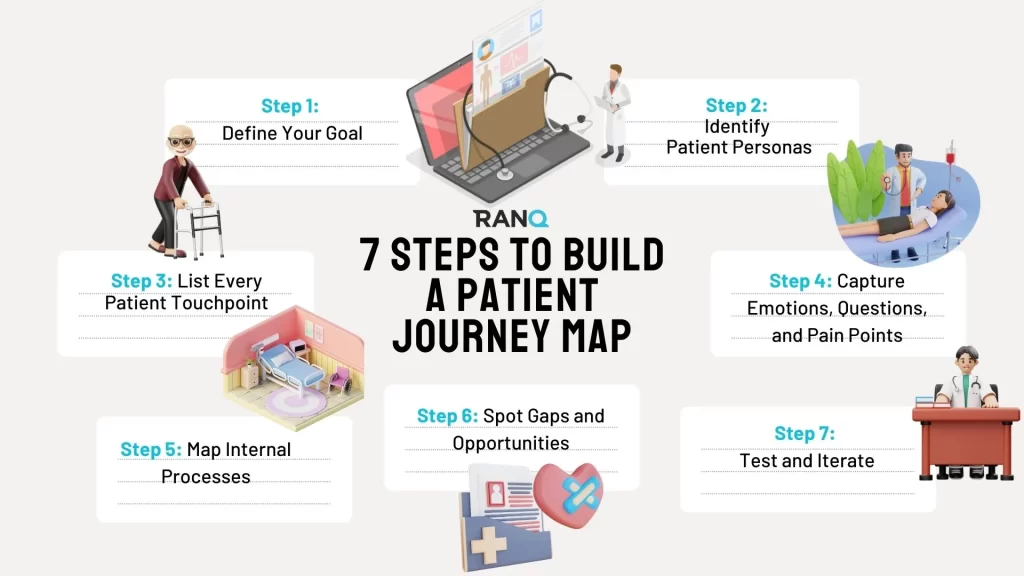The healthcare customer journey is a term that comprises the entire sequence of events that a patient goes through from the first time they experience symptoms all the way through to their aftercare and long-term treatment plans. It’s an essential cycle to think about for healthcare marketers and providers as it reveals possible pain points and opportunities for improvement in a customer’s healthcare experience. And it gives specificity to places where there may be knowledge gaps or opportunities for providers to offer additional care.
By examining and adjusting the full healthcare customer journey, you will be able to make choices that affect the patient’s engagement, satisfaction, and treatment outcomes based on the success of their experience.
What is the difference between the healthcare patient journey and other customer journeys?

Conceptually, the healthcare patient journey is comparable to other industries’ customer journeys, but medical care has additional emotional, logistical, and regulatory differences to remember. Still, the steps are largely the same for all customer journeys: Awareness, Consideration, Decision, Treatment, Follow-up & loyalty. Here are some of the differences compared to other industry customer journeys:
- Emotional intensity — Anything involving a person’s health is more emotionally urgent than customer journeys in other industries. When a person is scared, anxious, uncertain, or placed in a position where they need to trust others for their well-being, they’re going to react more strongly.
- Complexity — By necessity, healthcare patient journeys will be individual and branch out into various diagnostic and treatment options based on the patient’s specific health needs. Treatment for a kidney stone and treatment for a root canal will follow completely different paths from beginning to ending.
- Regulatory and Ethical Considerations — Regardless of their individual differences, all healthcare patient journeys must align with regulatory standards and ethical principles that other customer journeys do not need to navigate. These can include HIPAA, which dictates strict rules about how customer data is collected, and the need to treat the patient according to certain medical guidelines.
- Clinical Decision Points — Typical customer journeys have individual points to examine a customer’s experience, but the healthcare customer journey will require critical points where a person will need to make variable clinical decisions.
- Care Continuum — While a customer journey can ideally end in restarting the cycle, healthcare can be a continuum depending on what the individual needs. Some care may be a single operation, while other issues, like disease treatment, could require regular maintenance, support, and check-ins for proper care.
- Interdisciplinary Collaboration – Compared with other customer journeys, the same entity does not prescribe or deliver the care. Professionals can deliver healthcare from different specialties and disciplines. Therefore, your care could involve a combination of different providers with their own healthcare patient journeys.
Patient experience journey mapping – what is it?
A patient experience journey map is a tool that allows you to graphically and objectively review all of the touchpoints (interactions) that a patient has with a provider. It is a crucial tool in healthcare as it allows the provider to see the moments that cause the most friction with a patient.
Once those points have been completely identified, the provider can adjust communications, update the external and internal processes of touchpoints, or train staff based on the insights gathered. These maps are usually used throughout discussions about marketing strategy, patient engagement initiatives, and in defining the design of SaaS products.
How to build a patient journey map

In the next section, we’ll discuss the steps involved in building a patient journey map, and how it can be a powerful tool for providers in improving patient satisfaction and streamlining internal processes. With a carefully made patient journey map, providers can pinpoint the exact sequences of a customer’s experience that could lead to the patient either not returning or looking to another provider altogether.
Step 1: Define Your Goal
In the first step, you want to articulate the purpose of the patient journey map. Ask yourself, what do you want to learn or improve about the patient experience through the patient journey map (examples could be things like onboarding, follow-up care processes, reducing patient no-shows, etc.)?
It doesn’t need to be a single type of issue, but it needs to be a specific challenge. One possibility may be streamlining the experience for new patients who are scheduling appointments.
Step 2: Identify Patient Personas
Next, you’ll want to identify a few personas that can reflect your typical patients. Are they in a similar age range or are they dealing with chronic or one-time conditions? Create a few different personas and define their demographic details, common concerns, and care needs.
Step 3: List Every Patient Touchpoint
In the third step of mapping this journey, you’ll want to list every patient touchpoint (point of interaction) that a patient may have with your provider or business. These can include:
- Website or mobile search – Is your website easy to use and accessible on both desktop and mobile?
- Phone call or chatbot – Is staff responsive to phone calls? Does your chatbot or automated message system work with the patient’s needs?
- Appointment scheduling – Is it easy to make an appointment?
- Waiting room experience – Do patients feel welcome and seen?
- Clinical interaction – Was the patient satisfied with their time with the provider?
- Billing and follow-up – Was billing from your provider to your patient clear, and did the customer feel heard with any follow-up questions?
Step 4: Capture Emotions, Questions, and Pain Points
After listing the patient touchpoints, try to encapsulate how the patient may feel or think at every touchpoint. Are they feeling taken care of or satisfied with their experience? Each touchpoint will have its own unique questions and concerns.
For instance, at the scheduling stage, a patient may be anxious about the provider’s limited availability or confused about insurance requirements.
Step 5: Map Internal Processes
Once you’ve determined the patient’s broad experiences at each touchpoint, it’s time to outline what’s happening behind the scenes of the provider at each point. This can be delays in contact like staff tasks, automated emails, or needed handoffs between departments. By mapping these internal processes it helps teams see where breakdowns can occur and which improvements in the process would have the most significant impact.
Step 6: Spot Gaps and Opportunities
Now that you’ve created the full patient journey map, you can analyze the entire cycle to see where there can be redundancies, delays, unclear communication, or missed follow-ups.
Correcting some of these issues may be more involved, but some gaps can be filled in through coordinating automation or rewriting confusing forms. You might also be able to find new opportunities to provide for your patient.
Step 7: Test and Iterate
Finally, you want to share your patient journey map with the rest of your staff and those who can change your process. Consult the feedback you’ve received and refine and redraw the map to accommodate the current gaps or potential issues. Even if you’ve seemed to plug all of the holes, understand that you will have to periodically revisit your patient journey map as your systems or patient processes inevitably evolve.
Common issues solved with healthcare customer journey mapping

In the next section, we’ll discuss some common issues and pain points that providers can experience and how they can be addressed through patient journey mapping. If unchanged, these pain points can impact patient satisfaction, provider efficiency, and patient retention. When those issues are visible, healthcare teams can take action, whether the solution is digital, operational, or interpersonal adjustments.
Poor Online Visibility at the Start of the Journey
Many providers don’t realize how much of the healthcare customer journey relies on an organic search engine like Google – not a referral. If patients can’t find your website, geographical location, or the specific services offered, you will likely lose a patient. Through expertly implemented SEO-services and keyword-targeted content, you can increase your brand visibility as a healthcare provider, and drive more traffic.
Confusing Website Navigation or Lack of Key Info
One of the most common issues is a difficult-to-navigate website or one that lacks key information that potential patients may need to be addressed, like biographies about specific providers or unclear insurance information.
Through patient journey mapping, you’ll be able to identify which elements of your website are barriers for customers. Maybe it’s something as simple as reducing the number of words on a given page or making loading too slow.
Communication Gaps Across Channels
Journey maps are also a great method of revealing the point of breakdown between scheduling, care, and follow-up appointments with a patient. If a patient books online but doesn’t receive confirmation or never receives post-visit instructions, they’re unlikely to use your provider again. Automation tools, new messaging guidelines, or staff instruction can easily address these issues.
Low Patient Engagement or High Drop-Off Rates
More centrally than communication gaps, journey maps can expose the points at which patients abandon your provider’s journey. It could be an unfinished form or an unanswered call, but by identifying these drop-off points, you can directly respond to the exact location where these issues consistently occur. Through tools like surveys, tracking pixels, or call recording, you can also gather more analytics that will affirm or counter your suspicions about those issues.
Optimize your healthcare customer journey with RANQ!
When you fully understand and internalize your patient’s healthcare customer journey, you can deliver a more personalized, frictionless, and satisfying experience as a provider.
Through a healthcare customer journey map, you’ll be able to collaborate with a partner like Ranq, who can transform the insights of that journey into increased visibility, quality patient-facing content, and site improvements that can convert visitors into customers.
For healthcare providers and businesses who want to connect with their patients at every step of their journey, Ranq can close the gaps and create new opportunities to help you flourish as a provider.


